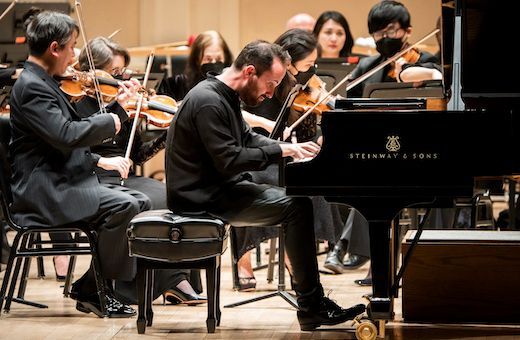Igor Levit can play the piano very softly, creating bright pearlescent lines of melody floating in clouds of harmonic mist. Making his debut with the New York Philharmonic last weekend in their stint at Carnegie Hall, his pianissimo playing was the highlight of the Brahms Piano Concerto no. 1 in D minor. The pensive chorales in the first movement were introspective and moving; the gnarly chromatic lines in the second were wistful and sparkly. There was a sense of direct, present communication, enhanced by an unselfconscious physicality, with gestures, bounces on the piano bench and communion-seeking turns to the orchestra.

For all its vaunted acoustics, Carnegie Hall is sometimes not kind to concerto soloists. When the orchestra was playing above a whisper, Levit was often very difficult to hear. His feisty and pugnacious fortissimo opening of the third movement was audible and satisfying, but a lot of the concerto’s virtuoso figuration essentially disappeared, and the pianist’s contribution to climactic passages had to be taken on faith.
The orchestra may have overbalanced the soloist at times, but they sure sounded good doing it. The strings especially were crisp and intense in the outer movements. Special mention to the frequently featured horn soloist, who matched Levit for presence, directness and sheer loveliness of sound. Levit’s encore, the Busoni transcription of Bach’s chorale prelude Nun Komm der Heiden Heiland, played to the same strengths as the concerto, ethereal and luminous.
My companion for the evening said of the Bartók Concerto for Orchestra that it “kicked butt,” and I really don’t have too much to add to that evaluation. Jaap van Zweden emphasized contrasts, making slow tempi a little slower, fast ones a little faster, and heightening dynamic differences where possible. A notable instance was the satire of Shostakovich’s Leningrad Symphony, the interruption in the Intermezzo interrotto movement, which was uproariously raucous, and then followed by butter-wouldn’t-melt-in-the-mouth beatific innocence. He made sure that Bartók’s fascinating accompaniment textures were present enough to anchor the foreground material. Then he got out of the way and let this extremely fine orchestra play a piece designed to showcase them.
The Philharmonic’s already formidable low brass section was an inexorable force sitting in the acoustic sweet spot at the back of the Carnegie Hall stage. The violins were by turns eerie, focused, angelic and ferocious. Everyone had their delightful moments, but frankly I just want to give the bassoon section a big hug. An orchestra is a collective endeavor, but it’s good to be reminded that there are individual personalities within.


